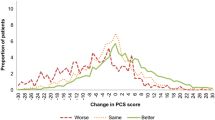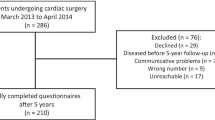Abstract
Objective:
To examine the responsiveness of the 36-Item Short Form Health Survey (SF-36) to clinical changes in three surgical groups and to study how health-related quality of life (HRQL) changes with time among patients who undergo total hip arthroplasty, thoracic surgery for treatment of non-small-cell lung cancer, or abdominal aortic aneurysm (AAA) repair.
Design:
Prospective cohort study with serial evaluations of HRQL preoperatively and at 1, 6, and 12 months after surgery.
Setting:
University tertiary care hospital.
Patients:
Of 528 patients, more than 50 years of age, who were admitted for these elective procedures, 454 (86%) provided preoperative health status data and are members of the study cohort. At 12 months after surgery, 439 (93%) of the cohort was successfully contacted and 390 (90%) provided follow-up interviews.
Measurements and main results:
The Medical Outcomes Study SF-36, the Specific Activity Scale, five validated health transition questions, and a 0 to 100 scale measure of global health were used to assess changes in health status at 1, 6, and 12 months after surgery. Change in health status as measured by the SF-36 demonstrated that physical function and role limitations due to physical health problems were worse 1 month after these three surgeries. However, by 6 months after surgery, most patients experienced significant gains in the majority of the dimensions of health, and these gains were sustained at 12 months after surgery. Longitudinal changes in the SF-36 were positively associated with responses to the five health transition questions, to changes on the Specific Activity Scale and global health rating question, and to clinical parameters for persons who had AAA repair. These findings indicate that the SF-36 has evidence of validity and is responsive to expected changes in HRQL after elective surgery for these procedures.
Conclusions:
For the total hip arthroplasty patients, responsiveness was greatest for the SF-36 scales that measure physical constructs. However, for the two other procedures and at various points of recovery, significant changes were observed for all eight subscales, suggesting that responsiveness was dependent on the type of surgery and the timing of follow-up, and that multidimensional measures are needed to fully capture changes in HRQL after surgery.
Similar content being viewed by others
References
Klevit HD, Bates AC, Castanares T, Kirk EP, Sipes-Metzler PR, Wopat R. Prioritization of health care services: a progress report by the Oregon Health Services Commission. Arch Intern Med. 1991;151:912–6.
Hadorn DC. Setting health care priorities in Oregon: cost-effectiveness meets the rule of rescue. JAMA. 1991;265:2218–25.
Daniels N. Is the Oregon plan fair? JAMA. 1991;265:2232–5.
Lansky D, Butler JBV, Waller FT. Using health status measures in the hospital setting: from acute care to ‘outcomes management.’ Med Care. 1992;30:MS57–73.
Kaplan RM, Bush JW, Berry CC. Health status: types of validity and the Index of Well-Being. Health Serv Res. 1976;11:478–507.
Bergner M, Bobbit RA, Carter WB, et al. The Sickness Impact Profile: development and final revision of a health status measure. Med Care. 1981;19:787–805.
Jette AM, Davies AR, Cleary PD, et al. The functional status questionnaire: reliability and validity when used in primary care. J Gen Intern Med. 1986;1:143–9.
Hunt SM, McEwen J, McKenna SP. Measuring health status: a new tool for clinicians and epidemiologists. J R Coll Gen Pract. 1985;35:857–9.
Stewart AL, Hays RD, Ware JE. The MOS Short-form General Health Survey: reliability and validity in a patient population. Med Care. 1988;26:724–35.
Ware JE, Sherbourne CD. The MOS 36-Item Short-Form Health Survey (SF-36), I: conceptual framework and item selection. Med Care. 1992;30:473–83.
McHorney CA, Ware JE, Raczek AE. The MOS 36-Item Short Form Health Survey (SF-36), II: psychometric and clinical tests of validity in measuring physical and mental health constructs. Med Care. 1993;31:247–63.
McHorney CA, Ware JE Jr, Lu JFR, et al. The MOS 36-Item Short-Form Health Survey (SF-36), III: tests of data quality, scaling assumptions, and validity among diverse patient groups. Med Care. 1994;32(1):40–66.
Hays RD, Sherbourne CD, Mazel RM. The RAND 36-Item Health Survey 1.0. Health Econ. 1993;2:217–27.
Ware JE, Kosinski M, Bayliss MS, McHorney CA, Rogers WH, Raezele A. Comparison of methods for the scoring and statistical analysis of SF-36 health profile and summary measures: summary of results from the Medical Outcome Study. Med Care. 1995;33:AS264–79.
Nerenz DR, Repansky DP, Whitehouse MD, et al. Ongoing assessment of health status in patients with diabetes mellitus using the SF-36 and diabetes TYPE Scale. Med Care. 1992;30:MS112–24.
Kurtin PS, Davies AR, Meyer KB, et al. Patient-based health status measurements in outpatient dialysis: early experiences in developing an outcomes assessment program. Med Care. 1992;30:MS136–49.
Ware JE, Snow KK, Kosinski M, Gandek B. SF-36 Health Survey: Manual and Interpretation Guide. Boston, Mass: Nimrod Press: 1993.
Stewart AL, Greenfield S, Hays RD, et al. Functional status and well-being of patients with chronic medical conditions, results from the Medical Outcomes Study. JAMA. 1989;262:907–13.
Brazier JE, Harper R, Jones NMB, et al. Validating the SF-36 Health Survey questionnaire: new outcome measure for primary care. BMJ. 1992;305:160–4.
Fryback DG, Dasbach EJ, Klein R, et al. The Beaver Dam Health Outcomes Study: initial catalog of health state quality factors. Med Decis Making. 1993:13(2):89–102.
Johnson PA, Goldman L, Orav EJ, et al. Comparison of the Medical Outcomes Study Short-Form 36-Item Health Survey in black patients and white patients with acute chest pain. Med Care. 1995;33:145–60.
Weinberger M, Kirkman MS, Samsa GP, et al. The relationship between glycemic control and health-related quality of life in patients with non-insulin-dependent diabetes mellitus. Med Care. 1994;32:1173–81.
Wu AW, Rubin HR, Mathews WC, et al. A health status questionnaire using 30 items from the Medical Outcomes Study: preliminary validation in persons with early HIV infection. Med Care. 1991;29:786–98.
Hays RD, Shapiro MF. An overview of generic health-related quality of life measures for HIV research. Qual Life Res. 1992;1:91–7.
Bousquet J, Knani J, Dhivert H, et al. Quality of life in asthma. I: internal consistency and validity of the SF-36 questionnaire. Am J Respir Crit Care Med. 1994;149:371–5.
Krumholz HM, McHorney CA, Clark L, et al. Changes in health after elective percutaneous coronary revascularization. Med Care. 1996;34:754–9.
Fifer S, Mathias SD, Patrick DL, et al. Untreated, anxiety among adult primary care patients in a health maintenance organization. Arch Gen Psychiatry. 1994;51:740–50.
Hays RD, Wells KB, Sherbourne CB, et al. Functioning and well-being outcomes of patients with depression compared to chronic medical illness. Arch Gen Psychiatry. 1995;52:11–9.
Wells KB, Burnam MA, Rogers W, et al. The course of depression in adult outpatients: results from the Medical Outcomes Study. Arch Gen Psychiatry. 1992;49:788–94.
Kantz ME, Harris WJ, Levitsky K, et al. Methods for assessing condition-specific and generic functional status outcomes after total knee replacement. Med Care. 1992;30:MS240–52.
Ritter MA, Albohm MJ, Keating EM, et al. Comparative outcomes of total joint arthroplasty. J Arthroplasty. 1995;10:737–41.
Dawson J, Fitzpatrick R, Murray D, Carr A. Comparison of measures to assess outcomes in total hip replacement surgery. Qual Health Care. 1996;5:81–8.
Anderson JG, Wixson RL, Tsai D, et al. Functional outcomes and patient satisfaction in total knee patients over the age of 75. J Arthroplasty. 1996;11:831–40.
O’Boyle CA, McGess H, Hickey A, O’Malley K, Joyce CRB. Individual quality of life in patients undergoing hip replacement. Lancet. 1992;339:1088–91.
Cleary PD, Reilly DT, Greenfield S, et al. Using patient reports to assess health-related quality of life after total hip replacement. Qual Life Res. 1993;2:3–11.
Phillips RC, Lansky DJ. Outcomes management in heart valve replacement surgery: early experience. J Heart Valve Dis. 1992;1:42–50.
Keoghane SR, Lawrence KC, Jenkinson CP, et al. The Oxford laser prostate trial: sensitivity to change of three measures of outcome. Urology, 1996;47:43–7.
Burney RE, Jones KR, Coon JW, et al. Assessment of patient out-comes after operation for primary hyperparathyroidism. Surgery. 1996;120:1013–9.
Currie IC, Wilson YG, Baird RN, Larmont PM. Treatment of intermittent claudication: the impact on quality of life. Eur J Vasc Endovasc Surg. 1995;10:356–61.
Goldman L, Hashimoto B, Cook EF, Loscalzo A. Comparative reproducibility and validity of systems for assessing cardiovascular functional class: advantages of a new Specific Activity Scale. Circulation. 1981;64:1227–34.
Lee TH, Shammash JB, Ribeiro JP, Hartley LH, Sherwood J, Goldman L. Estimation of maximum oxygen uptake from clinical data: performance of the Specific Activity Scale. Am Heart J. 1988;115:203–4.
Bindman AB, Keane D, Lurie N. Measuring health changes among severely ill patients: the floor phenomenon. Med Care. 1990;28:1142–52.
Dales RE, Belanger R, Shamji FM, et al. Quality-of-life following thoractomy for lung cancer. J Clin Epidemiol. 1994;47:1443–9.
Greenfield S, Apolone G, McNeil BJ, Cleary PD. The importance of co-existent disease in the occurrence of postoperative complications and one-year recovery in patients undergoing total hip replacement. Comorbidity and outcomes after hip replacement. Med Care. 1993;31:141–54.
Cleary PD, Greenfield S, Mulley AG, et al. Variations in length of stay and outcomes for six medical and surgical conditions in Massachusetts and California. JAMA. 1991;266:73–9.
Greenfield S, Sullivan L, Dukes KA, Silliman R, D’Agostino R, Kaplan SH. Development and testing of a new measure for case mix for use in office practice. Med Care. 1995;33(suppl):AS47–55.
Rosner B. Fundamentals of Biostatistics. Boston, Mass: Duxbury Press: 1986:286–7.
Liang MH, Larson MG, Cullen KE, Schwartz JA. Comparative measurement efficiency and sensitivity of five health status instruments for arthritis research. Arthritis Rheum. 1985;28:542–7.
McDowell I, Newell C. Measuring Health: A Guide to Rating Scales and Questionnaires. New York, NY: Oxford University Press; 1987:14.
Nunally JC. Psychometric Theory. New York, NY: McGraw Hill; 1978:190–255.
Mangione CM, Phillips RS, Lawrence MG, et al. Improved visual function and attenuation of age-related declines in health-related quality of life after cataract extraction. Arch Ophthalmol. 1994; 112:1419–25.
Cleary PD, Greenfield S, McNeil BJ. Assessing quality of life after surgery. Control Clin Trials. 1991;12:189–203S.
Author information
Authors and Affiliations
Additional information
Funded in part by a grant from the Agency for Health Care Policy and Research (1RO1-HS06573). Dr. Mangione is the recipient of a Clinical Investigator Award (1K08-AG00605) from the National Institute on Aging, and is an awardee of the Robert Wood Johnson Foundation Generalist Physicians Faculty Scholars Program (029250).
Rights and permissions
About this article
Cite this article
Mangione, C.M., Goldman, L., Orav, E.J. et al. Health-related quality of life after elective surgery. J GEN INTERN MED 12, 686–697 (1997). https://doi.org/10.1046/j.1525-1497.1997.07142.x
Issue Date:
DOI: https://doi.org/10.1046/j.1525-1497.1997.07142.x




